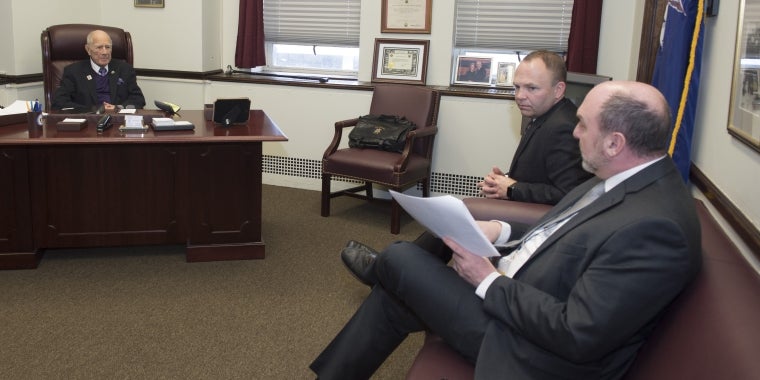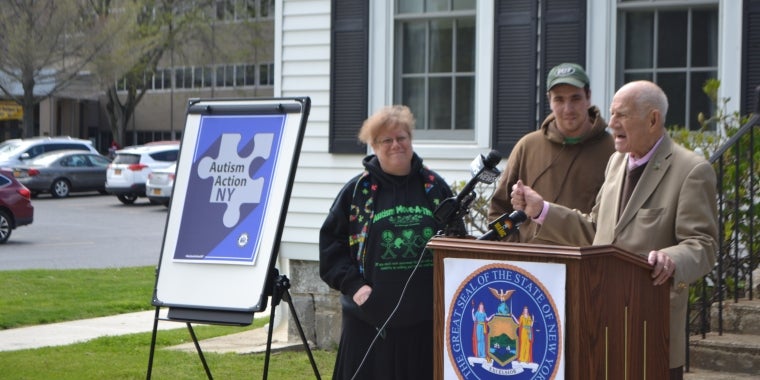
Senate Majority Coalition Announces Task Force on Lyme & Tick-Borne Diseases
William J. Larkin Jr.
October 7, 2013
-
ISSUE:
- Health
Panel To Develop Recommendations for A State Action Plan
To Increase Prevention, Improve Treatment and Diagnosis
Senate Majority Coalition Co-Leaders Dean Skelos and Jeffrey Klein today announced the creation of the Senate Task Force on Lyme and Tick-Borne Diseases to examine state and federal efforts to combat the continued spread of these diseases and make recommendations for a plan to improve prevention, diagnosis and treatment.
The task force will be co-chaired by Senator Kemp Hannon (R-C-I, Garden City), Chairman of the Senate Health Committee, Senator David Carlucci (D, Rockland/Westchester), Senator Kenneth LaValle (R-C-I, Port Jefferson) and Senator Elizabeth Little (R-C-I, Queensbury). Other members of the Senate Task Force on Lyme and Tick-borne Diseases include: Senator Mark Grisanti (R, North Buffalo), Senator Kathleen Marchione (R-C, Halfmoon), Senator Greg Ball (R-C-I, Patterson), and Senator Bill Larkin (R-C, Cornwall-on-Hudson).
The panel will work on recommendations for a state action plan to address Lyme and other tick-borne diseases modeled after the “2001 West Nile Virus Response Plan.” That plan was developed by the New York State Department of Health in response to the West Nile Virus outbreak in 1999, and New York needs a comparable plan to move the state forward in prevention, diagnosis and treatment of Lyme and other tick-borne diseases.
Senator Larkin said: “I want to thank Senate Majority Co-Leaders Skelos and Klein for recognizing the importance of Lyme and tick-borne diseases and making their prevention and treatment a priority for the Senate. With the extreme prevalence of Lyme and other tick-borne illnesses in the Hudson Valley I am looking forward to making sure that the needs of our friends, neighbors, and family members who suffer from these debilitating diseases are addressed.”
Senator Hannon said: “While knowledge of Lyme and other tick-borne diseases has been available for many years, far too many people continue to suffer the effects of tick-borne illnesses, demonstrating a need for further action. The consequences of undiagnosed, misdiagnosed, untreated and mistreated infections from ticks can be serious and debilitating. State and federal agencies must work together with local communities and experts in the field to help develop a comprehensive plan to increase prevention and improve diagnosis and treatment in New York.”
The Centers for Disease Control recently estimated that about 300,000 individuals are diagnosed with Lyme each year nationally. Lyme is the most commonly reported of all tick-borne illness in the United States. There are 13 states that account for almost all of those cases; many of the cases are in New York.
There are also fears that Lyme disease may, in fact, have broader consequences than the symptoms we generally associate with the illness. According to recent news analysis of state Health Department records, over the past 13 years, Lyme disease was listed as the cause of deaths for nine New Yorkers, outside of New York City. Five of the victims lived in the mid-Hudson Valley. Given the number of cases and severe effects that Lyme and other tick-borne diseases can cause, New York must take action.
The task force will explore innovative ways of addressing tick densities, such as the “Four- poster” deer tick program that uses deer feeding stations designed in such a way that the animal must put its neck, where most of the ticks congregate, through two gentle rollers that contain an insecticide to kills ticks. Studies of the four-poster system, including one by Cornell, have shown a remarkable reduction in the tick population.
The Task Force will review research, consult with experts, hear from the public and work with the appropriate State and Federal agencies in developing recommendations for a New York State Action Plan on Lyme and tick-borne diseases which can serve as a comprehensive roadmap for the state to improve diagnosis and treatment to prevent future tragedies.


